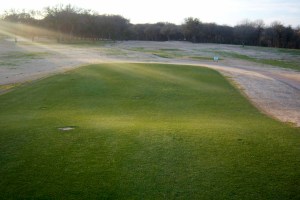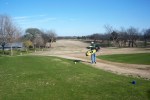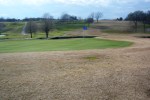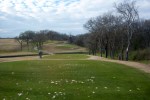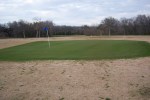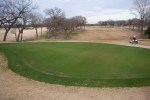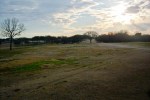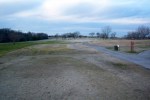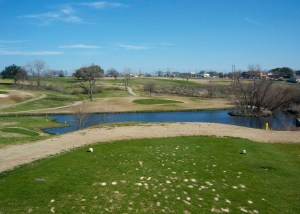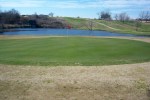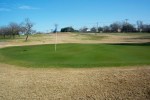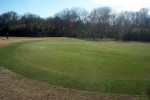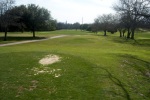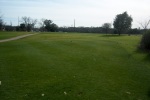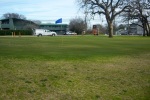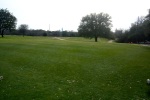The Jimmy Clay/Roy Kizer golf complex is far and away my favorite place for public golf in Austin. All in one place you have two 18-hole courses, two putting greens, a driving range with lights for night practice and a short/practice course consisting of four par 3’s and its own separate putting green and practice bunker.
The two courses are both moderately priced, Jimmy Clay features a more American country club style with narrow, tree-lined fairways and Roy Kizer is a wide open links-style course and a bit more expensive. If you don’t have time for an entire round, it’s only $5 to practice on the short course and you can play it and use the putting green and practice bunker as much as you like. Great deal.
Today I’m going to focus on Jimmy Clay because I find the layout more challenging due to the doglegged, tree-line fairways. I have no problem with links-style golf, I just find Jimmy Clay is a bit more difficult to navigate if you’re new to the course due to the abundance of trees.
#1 par 4 385 yds.
The first hole is a sharp dogleg left with water all along the left side. You may occasionally see golfers intentionally hit the ball over the water and on to the ninth fairway to get a better, closer angle to the green. Even if you don’t feel it’s your place to correct them, notice that there are white stakes along the outside of the water hazard indicating that playing that route is illegal, out-of-bounds, and the golfer should be taking a stroke and hitting his third shot from the tee-box. Your approach shot must be straight because the water still lurks on the left and thick trees pose trouble on your right. The green slopes back to front and features two bunkers, one on the left and one on the right. Finding yourself in these bunkers isn’t terrible. It’s better than being in the water or punching out of the trees.
#2 par 3 134 yds.
This is short par three into an hourglass green that gets pretty narrow around the neck. The surface itself is fairly flat but does roll of the back of the green down the hill. It’s much better to be short, below the hole than to be long or in either bunker guarding the front-right and back-left of the green. Club selection is key on this hole. Get a good feel for what the wind is doing before you tee-off.

From the blue tees, #3 might be the most difficult driving hole of all the public courses in Austin.
From the blue tees, this might be the most difficult driving hole of all the public courses in Austin. The narrow fairway doglegs sharply to the right and both sides are heavily guarded by thick trees. If you push your drive right, blast it. There is a clearing in the trees. You have to hit it pretty far to get there but trust me it’s there and you’ll have an open shot to the green. Whatever you do, don’t go left. The fairway itself slopes from right to left toward the trees and there’s a steep run-off along the tree-line that will cause your ball to roll down into the creek. The green itself is turtlebacked and not terribly difficult to put on. Getting started off the tee is the problem.
#4 par 5 540 yds.
From the tee it looks like you don’t have much room on your drive. The truth is, there’s plenty of room on your right once you get past the immediate trees right in front of you. Don’t go left. The trees are too think and you won’t be able to find your ball. Aim toward the pair of bunkers on top of the hill and hit a slight draw if you have one. From there it’s a straight shot, or two depending on how aggressive you are, to an elevated green that runs off the back. The surface is two-tiered and is guarded by two front bunkers. Whatever tier the pin is on that day is where you want to be.
#5 par 3 98 yds.
A 98 yd. par 3 with no bunkers or water should be a walk in the park, but for some reason this hole drives me crazy. It’s all about distance and wind. The green itself is narrow from front to back and runs off if you’re short or long. You’re definitely going to have a wedge of some sort in your hand for this shot, but which wedge to chose is always my problem. Study the wind, trust your distances, decide on a club and strike it clean. If you land on the green, putting is cake on this hole. If you go long and find yourself at the bottom of the hill, you’re not alone. I’ve been there plenty. Just be careful on your chip back up to the green. The last thing you want is to go long and run off the front of the green and be in the same position you are now, from the other side.
If you’ve never played here before, you can’t see the green or the water from the tee-box. Just know that they are definitely in reach. Oh yeah and by the way, the green is an island. Keep the driver in your bag, grab a long iron and hit a straight shot. From there you’ll be left with a 100 yd. wedge into the island. If you go left off the tee, you’ll lose your ball in the woods. If you go right, you’ll be able to find your ball, but will have no shot at reaching the island green in two. So here you are, 100 yds. away from the green with a wedge in your hand. Under any other circumstances you can hit this green 10-out-of-10 times. There’s just something about island greens that cause you to doubt yourself. Fight through it. Trust your swing. If you’re undecided when you address the ball, step back and go through your routine again. Forget about where the pin is and aim for the middle of the green. Bragging rights for the rest of the round are yours for the taking.
#7 par 5 468 yds.
Number 7 is a short par 5 in terms of distance, only 468 yds. long, but it’s all uphill. No real hazard threats on this hole, just put together two or three good, solid shots and work your way up the hill. The green is elevated, guarded by two bunkers and has a ridge that runs through the middle of the surface. The green drops off back-right and off the front so landing in a bunker on your second or third shot is actually better than catching the run-off and rolling all the way down the hill. Don’t be tempted by a flagstick that’s tucked near one of those runoffs. Aim for the middle of the green and give yourself an opportunity at birdie or par.
This par 4 is long, doglegs hard the left and is extremely narrow. Off the tee, you have to be either straight of slightly off to the right. If you go left, you’ll have absolutely no chance of reaching the green in two. Your approach shot demands precision because of the thick trees on the left and right of the fairway. There are two bunkers on the front-left and front-right that you must clear but don’t hit it too far, because the green runs off the back and right down the hill. I’m not going to lie, this is a difficult hole. Walking away with par is a great victory.
#9 par 4 386 yds.
You’ll see people take a lot of different angles off the tee on #9. The safest route is just to the left of the cart-path with a slight fade back to the right. A lot of players will aim to blast it over the two trees right in front of you, but be careful about going that route. There is a wooden fence just to the right of the trees that is out of bounds. If you push the ball even a little to the right, you’ll be O.B. and teeing off again on with your third shot. The green itself is elevated and guarded by a deep bunker that stretches across the front of the green. Once I get my distance, I always use one club higher than what I would normally hit because of the green’s elevation. From a perception standpoint, it’s misleading because it looks a lot closer than it really is. The surface slopes from back to front and rolls of the left and right of the green. You want to be on the front, putting uphill rather than on the back putting down, but make sure you don’t leave your approach too short. That bunker is deep and can be extremely unpleasant.
Next Friday: back-nine at Jimmy Clay G.C.

